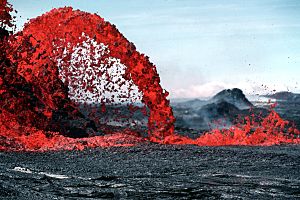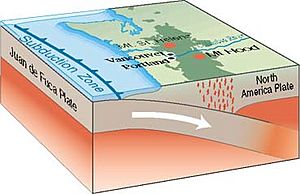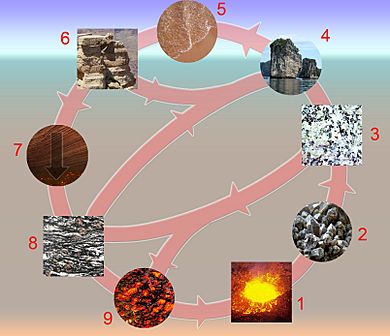Rock cycle facts for kids
The rock cycle is a natural process where rocks constantly change from one type to another. It's like Earth's way of recycling!
There are three main kinds of rocks: igneous rock, metamorphic rock, and sedimentary rock. Each type can transform into the others through different natural processes. These include cooling, melting, intense heat, weathering (breaking down) and erosion (carrying away), compacting (squeezing tightly), cementing (gluing together), and pressure.
When rocks are heated deep underground, they can turn into magma, which is liquid rock. If this liquid rock comes out onto the Earth's surface, it's called lava. Small pieces of rock, dirt, and other materials created by weathering and erosion are called sediment. This sediment is the starting point for new sedimentary rocks.
Igneous rock forms when magma or lava cools and hardens. This can happen deep inside the Earth or on the surface after a volcano erupts. Igneous rock can melt back into magma, break down into sediment, or be squeezed and heated to become metamorphic rock.
Metamorphic rock forms when existing igneous or sedimentary rocks are put under extreme heat and pressure. This often happens deep inside mountain chains. Metamorphic rock can also break down into sediment or melt into magma.
Sedimentary rock forms from layers of sediment that get compacted and cemented together over time. This sediment can come from any type of rock, and it can also include the remains of living things. Sedimentary rock can erode back into sediment, or it can be buried and squeezed into metamorphic rock. It can also melt into magma, which then forms igneous rocks.
These changes happen in a continuous cycle, and the Earth always has processes that transform rocks. For example, wind and water can break down rocks into sediment. Also, the movement of Earth's tectonic plates creates huge amounts of heat and pressure, which greatly affect rocks. When one plate slides under another (a process called Subduction), rocks can be pulled deep enough to melt into magma, which then becomes part of the rock cycle again as igneous rocks.

Contents
How Rocks Change
Earth's moving plates are a major force behind the rock cycle. In 1967, a scientist named J. Tuzo Wilson wrote about how ocean basins repeatedly open and close. This idea, known as the Wilson cycle, helped us understand that plate tectonics is the main reason rocks keep changing.
Moving Plates and New Rocks
Ocean Ridges
At places where tectonic plates are pulling apart, like the mid-ocean divergent boundaries, new magma rises from deep inside the Earth. This magma cools and hardens to form new basaltic rock. This is the very first step for some igneous rocks. As the plates move away from the ridge, hot seawater flows through cracks in the new rock. This water causes the rock to change in a process called retrograde metamorphism.
Subduction Zones

As the new basaltic oceanic crust moves away from the ridge, it eventually reaches a subduction zone. Here, one plate slides underneath another and is pulled back into the Earth's mantle. As the rock goes deeper, the pressure and temperature increase. This causes the minerals in the rock to rearrange, forming a new type of metamorphic rock called eclogite.
As the rock slab and any attached sediments are dragged even deeper, water and other gases are released. These gases rise into the rock above the subduction zone, where the pressure is lower. The lower pressure, high temperature, and the presence of these gases cause the rock in this area to melt. The melted rock (magma) then rises to the surface, creating island arcs or continental margin volcanism (volcanoes).
Sometimes, pieces of the deeply changed rock can be pushed back up to the surface. These pieces of mantle rock and metamorphic eclogites can be seen in places called ophiolite complexes.
Volcanic rock that erupts is quickly broken down by erosion, depending on the weather. These sediments collect in basins near the volcanic islands. As these sediments get buried deeper, they turn into sedimentary rock.
Colliding Continents
When two continents or smaller landmasses crash into each other, neither can easily slide underneath the other because they are both made of lighter rock. When they collide, huge forces squeeze and change the rocks. This intense pressure and heat cause widespread metamorphism within the new orogeny (mountain range) that forms. As the two landmasses are squeezed, folded, and faulted into a mountain range, all the existing igneous, volcanic, sedimentary, and older metamorphic rocks are changed by this new event.
Fast Erosion
The tall mountain ranges formed by continental collisions are immediately attacked by erosion. Erosion wears down the mountains, creating huge piles of sediment in nearby oceans, shallow seas, and on land. As these sediment piles are buried deeper, they turn into sedimentary rock. The metamorphic, igneous, and sedimentary rocks from the mountains become the new sediments in the nearby basins, eventually turning into sedimentary rock themselves.
A Changing Process

1 = magma;
2 = crystallization (rock freezing);
3 = igneous rocks;
4 = erosion;
5 = sedimentation;
6 = sediments & sedimentary rocks;
7 = tectonic burial and metamorphism;
8 = metamorphic rocks;
9 = melting.
The rock cycle, driven by plate tectonics, is always evolving. When magma forms, especially at spreading ridges or above subduction zones, it tends to bring out the lighter, more gas-rich parts of the Earth's crust or upper mantle. This lighter material usually stays in the crust and doesn't get pulled back into the mantle. This means that over time, the continental landmasses tend to grow larger.
The Role of Water
Water plays a very important part in the rock cycle. The most obvious ways are through weathering and erosion. Water from rain, and acidic water in soil and underground, is very good at dissolving minerals and rocks. This is especially true for igneous, metamorphic, and marine sedimentary rocks that are not stable near the Earth's surface. Water carries away dissolved minerals and broken rock fragments. Rivers carry huge amounts of sediment to the ocean and inland basins. These collected and buried sediments then turn back into rock.
Water also plays a less obvious role in metamorphism. For example, hot seawater flows through cracks in new volcanic rocks on the seafloor, changing them. This process, like serpentinization, helps break down volcanic rock.
Water and other gases are also crucial for melting existing crustal rock above subduction zones. Along with water, carbon dioxide and other carbon compounds from limestone in the sediments on the sinking plate also help rocks melt. This shows how the carbon cycle is connected to the rock cycle.
Images for kids
-
The rock cycle and plate tectonics.
-
This diamond is a mineral found in igneous or metamorphic rock, formed under high temperature and pressure.
-
Structures of Igneous Rock. A = magma chamber; B = dyke; C = laccolith; D = pegmatite; E = sill; F = stratovolcano. Processes: 1 = newer rock cutting through older rock; 2 = xenolith (rock piece inside another); 3 = contact metamorphism; 4 = uplift from laccolith.
See also
 In Spanish: Ciclo litológico para niños
In Spanish: Ciclo litológico para niños




